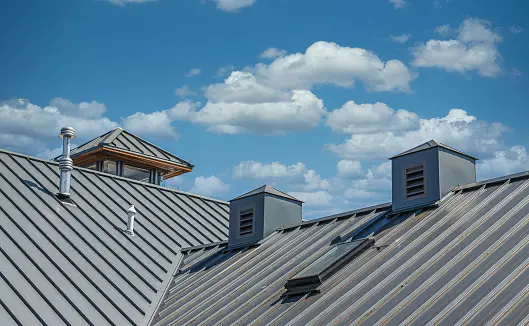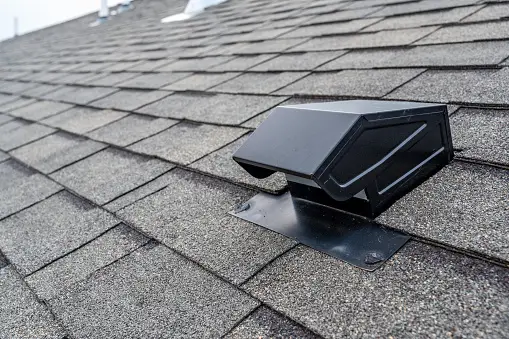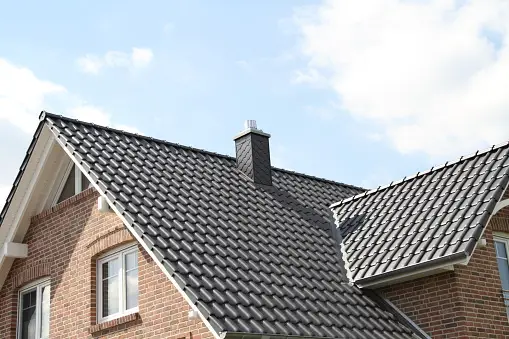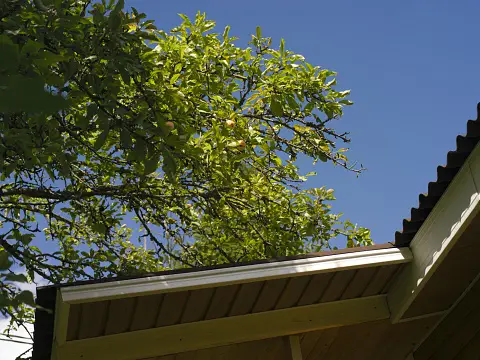This year’s summer season is predicted to be one of the hottest on record. One effective strategy to ensure your home stays cool and comfortable is to opt for a cool roof.
A cool roof reflects more sunlight and absorbs less heat than a regular roof, significantly enhancing your home’s energy efficiency and overall comfort during the sweltering summer months. Read on to learn more about how to keep your roof cool this summer.
Why Roofs Heat Up in Summer
Understanding the factors contributing to roof heating can help you make informed decisions on how to keep your roof cool this summer.
Understanding the factors that contribute to roof heat absorption
Sun exposure
The primary factor influencing roof heat is sun exposure. The amount of sunlight your roof receives significantly impacts heat absorption. Roofs with prolonged sun exposure and no shading, such as from trees or neighboring structures, tend to absorb more heat.
Roof color and material
The color and material play crucial roles in heat absorption. Dark-colored roofs absorb more heat compared to light-colored roofs. Materials such as metal or coated shingles are made to reflect more sunlight, as a result, reducing heat absorption.

Insulation levels
Insulation acts as a barrier, stopping heat from penetrating your living spaces. With poor insulation, more absorbed heat will be transferred inside, which will significantly impact the indoor temperature.
Ventilation
Ventilation lets hot air out and circulates cooler air. A good ventilation system can make living room spaces cooler.
Benefits of a Cool Roof
A cool roof offers multiple benefits beyond maintaining a comfortable indoor temperature. It can significantly lower energy bills and extend the roof’s lifespan.
By reflecting more sunlight and absorbing less heat than a standard roof, a cool roof keeps indoor temperatures cooler, reducing the need for air conditioning. This lowers overall energy usage, leading to noticeable reductions in monthly utility bills. Additionally, lower energy consumption means a reduced carbon footprint, contributing to environmental conservation efforts.
Furthermore, cool roofs absorb less heat, making them less likely to deteriorate as quickly as darker-colored shingles. Constant heating and cooling cycles cause roofing materials to expand and contract, leading to damage. By minimizing these cycles, a cool roof can last longer and require fewer repairs.
Choosing the Right Roofing Materials
Using what we know about how materials affect heat absorption, choosing the right roofing materials for your house, especially in hot climates, is essential.
Metal is a good choice when it comes to materials. It has reflective properties that help bounce off the sun’s rays, preventing excessive heat absorption. Additionally, metal roofs are durable, long-lasting, and can be coated with special finishes to enhance their reflective capabilities.
Other alternatives include clay or concrete tiles, which are highly effective in hot climates due to their natural thermal resistance. These materials can withstand high temperatures and provide good insulation, keeping the home cooler. Their durability makes them a popular choice in regions with intense heat.
Roof Insulation and Ventilation
You can maintain a cool temperature inside your home this summer by choosing the right roofing materials and colors, along with a solid insulation and ventilation system.

Proper ventilation is crucial for maintaining a comfortable, cool temperature. Ventilation like ridge vents and attic fans, allows hot air to escape and cooler air to circulate. This airflow helps dissipate heat and reduce the overall temperature of the roof.
Tips to Keep Your Roof Cool
Use Light-Colored or Reflective Roofing Materials
Opt for light-colored shingles, which are excellent for hot climates due to their effectiveness in reflecting more sunlight. Dark-colored shingles absorb more heat, increasing the temperature inside your home. Choosing light-colored or reflective roofing materials can help minimize heat absorption, keeping your home in a comfortable temperature and more energy-efficient.
Install Attic Ventilation
Install vents, such as ridge vents and soffit vents, to facilitate the flow of cool air into the attic and hot air out. This helps prevent heat buildup in the attic space. Along with ventilation, ensure your attic has sufficient insulation to prevent absorbed heat from penetrating into your living spaces, maintaining a more consistent indoor temperature.
Apply Roof Coatings
Applying reflective roof coatings is another effective way to keep your roof cool. Coatings are designed to reflect sunlight, reducing the amount of heat your roof can absorb. By reflecting sunlight, coatings can also help protect your roof from UV rays and thermal expansion, which prevents damage and extends its lifespan.
Plant Shade Trees
Next on our list of how to keep your roof cool this summer is planting shade trees! Planting shade trees is a natural and effective way to keep your roof cool. By positioning trees strategically around your home, you can provide shade that reduces the amount of direct sunlight hitting your roof.
Use External Shading Devices
Installing awnings or shades over your windows is an excellent way to minimize direct sunlight. These devices block the sun’s rays, keeping your home cooler by reducing the heat that enters through your windows. This not only makes your indoor environment more comfortable but also reduces the load on your air conditioning system.
Regular Roof Maintenance
Last but not least, regular roof maintenance is crucial for keeping your roof in good condition and spotting any damages early for prompt action. Ignoring routine maintenance can lead to significant issues, as minor damages left unchecked can become more severe and costly to repair. Regular inspections and timely repairs help ensure your roof remains effective at keeping your home cool and protected.
End Note
The key how to keep your roof cool this summer is to understand the sources of heat absorption and take steps to minimize it. Opting for light-colored and reflective roofing materials reduces the amount of heat absorbed. Moreover, ensuring adequate insulation and a sound ventilation system can eliminate heat buildup inside your home. Next, strategically use trees and shading devices to block direct sunlight. By following these steps and maintaining regular roof maintenance, you can effectively lower the temperature inside your home during the summer, save on energy costs for air conditioning, and keep your roof in top condition!
For expert roofing solutions, turn to JP Roofing. With our extensive experience and deep understanding of roofing, we can address any issues you may have with your roof. Contact us for more information, and we’ll be more than happy to assist you!
 (412) 829 7711
(412) 829 7711


Recent Comments